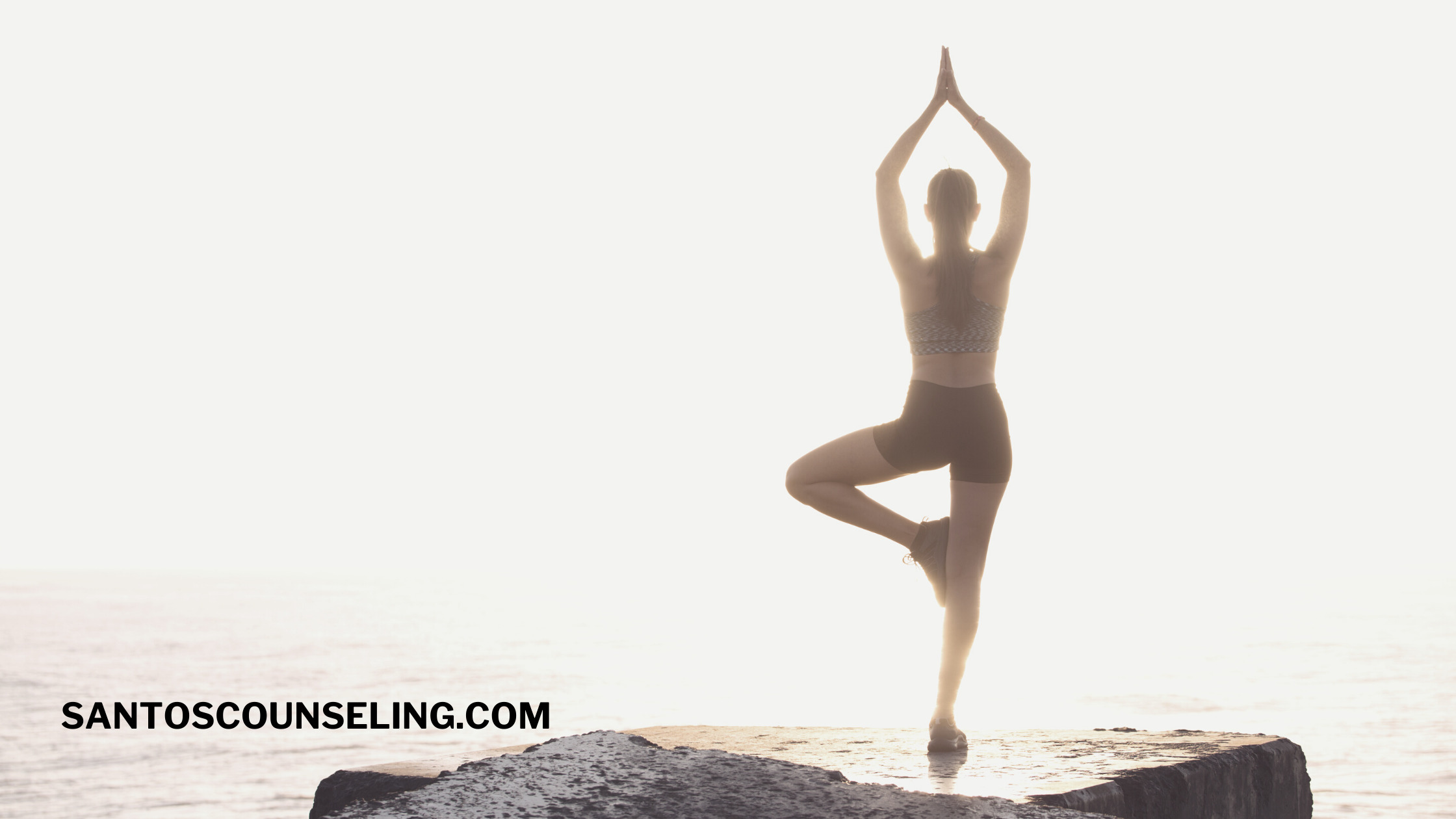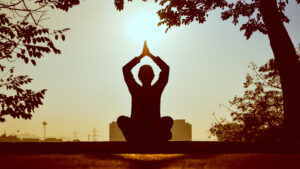Did you know that yoga is wonderful for anxiety?
Yoga has a beautiful relationship with breathing. Which is extremely important when it comes to mental health and specifically addressing anxiety.
Just about every movement in yoga incorporates breathing to a certain extent. When a person experiences difficulty connected to their mental health, their breathing is often a key area of concern.
Think about the last time you experienced anxiety.
The first step in adding YOGA to your life is getting your hands on a yoga mat. CLICK HERE to check out yoga mats that may be a good fit.
Some people notice that they can’t breathe at a normal rate. Others share that they experience muscle tension.
As a clinician and fitness enthusiast (this is Juan Santos), I love encouraging my clients or those willing to listen to add yoga to their lifestyle. Here are key reasons why yoga helps to reduce and address anxiety.
When you experience anxiety, what comes to mind?
The Diagnostic and Statical Manual of Mental Disorders coins anxiety disorder with the symptoms below:
- Problems focusing and concentrating
- Difficult making decisions
- Problems sleeping
- Irregular changes in appetite
- Feeling worried more days than not
- Problems controlling the worry
- Fear of something bad happening
Benefits of practicing yoga include:
- Reduction in stress.
- Improvement in pain, such as back or neck pain.
- Understanding and managing pain.
- Ability to connect to a community. Such as joining a yoga club in your area or online as a way to connect with a supportive community.
- Improvement in circulation.
- Reduction in risk to injury.
- Improvement in muscle tone, strength, and flexibility.
Let me ask you a question.
Would you agree that just about everyone experiences stress in life?
Stress is connected to anxiety.
Stress from family conflict or from the typical struggle to establish work and life balance. When a person feels stressed their body and mind react.
Think about what stress does to you?
- Do you feel overwhelmed when stressed?
- Do you struggle to sleep when stress is out of control?
When a person experiences stress, they begin to experience irregular breathing that leads to poor circulation. They feel the tension in the body. The tension leads to headaches. Sleep becomes irregular. And before you know it, life becomes a little more difficult.
Adding yoga to your lifestyle creates a powerful transformational change.
Yoga and breathing.
Yoga teaches people to understand how to breathe in a manner that regulates heart rate and improves blood pressure. This right away helps us when we feel stressed. Consider a week that you are struggling with work and life balance. You feel on edge, overly worked, and at times agitated because you are not able to do the fun things that you want to do.
The struggle with work and life balance builds stress. To address stress, a person can engage in yoga prior to work and right before getting home from work. The yoga session can focus on breathing and slowing down. For 5 minutes the person can engage in a wide-leg child’s pose.
This posture starts by coming down on all fours. Next allow your hips to sit back as you spread your knees to a comfortable wide position. Your hands extend forward, your forehead rests on the floor, and the belly sits close to the floor.
For 5 minutes you breathe and allow your mind to focus on the breathing. In and out. When the mind wanders, simply pull it back to focus on breathing. It’s completely okay for it to wander. At the end of the day, that’s what it’s supposed to do. Wander. Just like the legs are supposed to walk.
This activity beautifully reduces stress and clears the mind. Too often people race through life or tell themselves that tomorrow they will get better. Instead, give yourself 5 minutes twice a day to practice this method as a way to improve your mental health.
Mind and Body Relationship.
Yoga teaches people how to build a stronger relationship with their bodies. It’s vital to build a connection between mind and body. For instance, the simple cat and cow pose takes place with the person on all fours. They then stretch just like a cat would. The back spikes up for the cat and it drops down into a bend for the cow. During this process, the person is inhaling and exhaling. They are focused while moving to identify how their body feels.
During the process, you are able to reflect on the pain or overall feel in your body. In addition, you can notice how your mind wanders. During the yoga posture, you’ll notice if your mind is at ease or if it is pulled towards stress in life. The goal is simple. To slow down. To give yourself space to heal, grow, and create transformation.
If you are struggling with mental health challenges in your life, consider yoga. Treat it like a subscription. Just like as if you are subscribing to HBO Max for a period of time to see if you want to keep it around. For 30 days add yoga to your life.
How Mindfulness Connects To Yoga
Mindfulness in practice is simply pushing yourself to be aware of what is taking palace. Mindfulness is strongly connected to the practice of yoga. When you are experiencing anxiety or worry related symptoms take time to explore your emotional state using the practice of mindfulness.
To explore your emotional state, focus on reflecting on the following questions.
- Am I carrying any stress?
- Am I carrying any resentment?
The purpose of the questions is to give yourself space to understand how you are feeling and what you can do about it.
Let’s imagine that the answers to the questions above are yes. You are carrying stress and in addition, you are carrying resentment.
To address the unwanted symptoms, you can practice the strategies below.
Practice journal writing. This grounding process takes place with scheduling time to release tension connected to thoughts and feelings. CLICK HERE to see if the 5-minute journal is a good fit.
A weighted blanket. Negative or unwanted symptoms of come out in a physical way. You may find yourself feeling anxious and physically restless. You may also find yourself feeling sad or irritable while physically noting that your muscles ache. Using a weighted blanket can provide relief for unwanted symptoms. CLICK HERE to check out the weighted blanket.
Visualize yourself doing something that is fun or brings you pleasure. This grounding process connects you to an activity that you enjoy to some degree which helps to promote inner peace. Let’s picture that you enjoy going on walks. One of your favorite parts is watching the leaves and wind move through the trees. You can practice visualization by focusing on what the process looks like for you. I encourage you to try it out. You’ll notice a sense of peace and calm.
Practice grounding exercises. A simple grounding exercise is to give yourself 10 minutes three times a day. Once in the morning, in the middle of the day, and in the evening prior to bed. Spend 5 minutes in meditation. This can simply be closing your eyes and breathing in and out for 5 minutes. The next 4 minutes write down what you are grateful for. The last-minute focus on how you want to enter life with a positive mindset. Such as “I will enter life with a projection of self-love, kindness, and compassion.”
Pick up an object near you. This can be anything from a leaf on the floor or a pencil next to you. Pick up the item and think about how it feels. Run your hands gently across the top and sides. Think about how it feels as you touch it. If you can squeeze it, then squeeze it. Do your best to play with it so that you are creating an experience.
I hope that as you start yoga you’ll notice the beautiful benefits of it:
Have fun!








